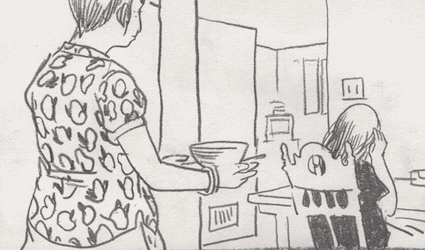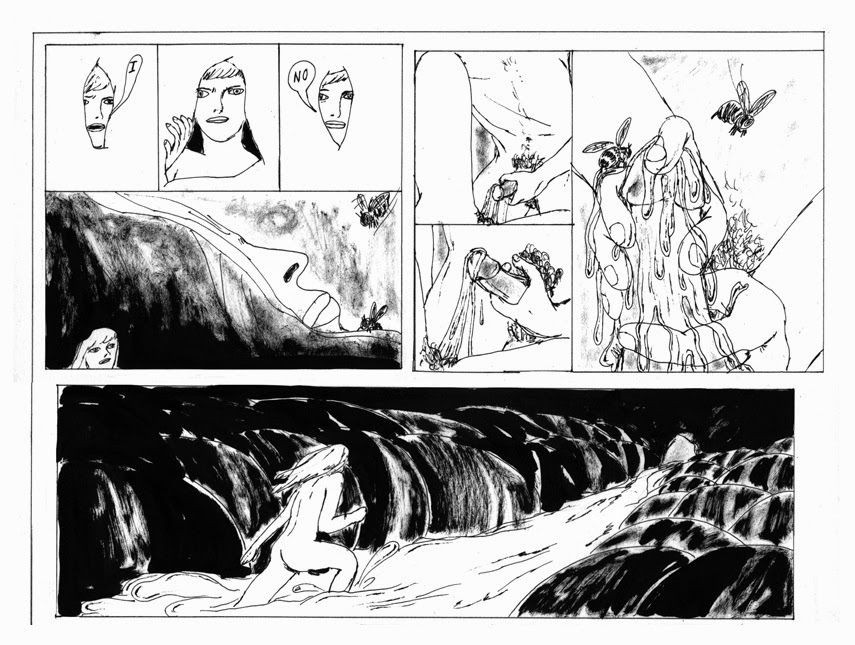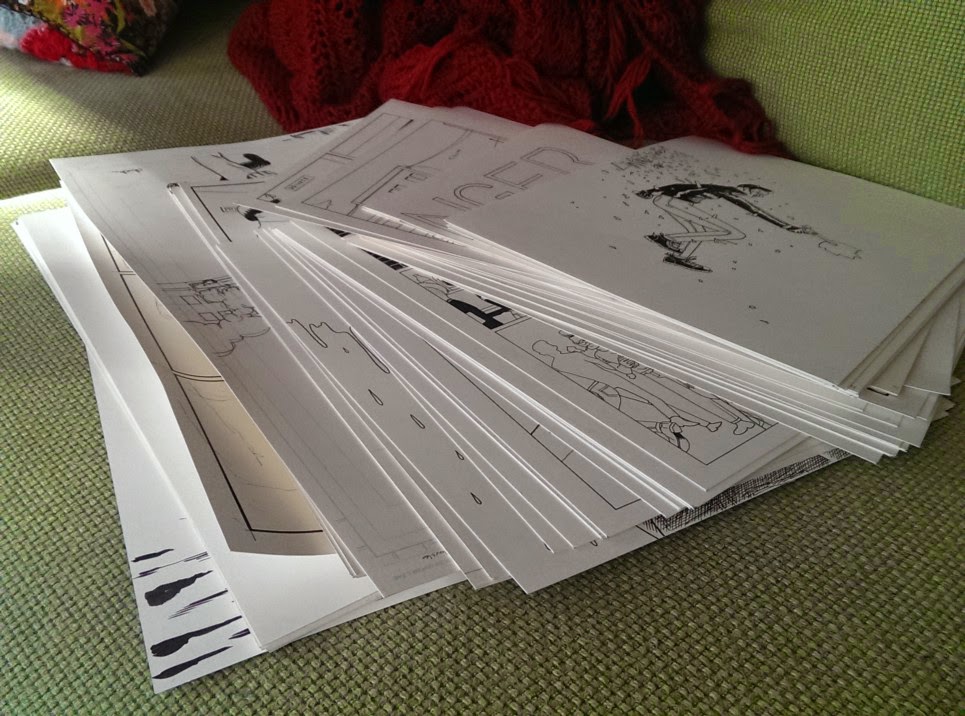This is a list of 8 webcomics from throughout the year (‘14) that I enjoyed. I’m probably missing a few from earlier in the year, but sadly that tends to be how these lists work. They are in no particular order, not even alphabetical, and the length I spend talking about each one shouldn’t be read as meaning anything besides an indictment of my laziness. At the bottom I also link to some other webcomics that I felt were worth mentioning or that someone I respect suggested I read and haven't gotten around to. Again I’m very lazy.
------------------------
The previous three issues of Sex Fantasy could be seen as a set up for this issue, lulling the reader into a false sense of knowing. What started as a gag comic about outlandish sex fantasies slowly transformed over its previous three issues into a exploration as to what those fantasies reveal about the person acting them out, and what ones inner thoughts and anxieties play into them.
![]()
Sex Fantasy #4 opens with an unnamed female sitting on a couch, wearing a black sweater and reading a book. Quickly though a pair of arms shoot through the left panel border and another female, this one wearing glasses, begins to rest her head on the woman on the couches right shoulder and lock her hands together around the woman's neck in a loose hug of sorts. The intimacy of this gesture seems to implicate a closeness between the two figures, and as the previous three issues have conditioned you to expect, you await the figure in glasses to begin whispering her odd sex fantasies into the sitting womans ear.
The fantasies you expect to see here though never come, although the intimacy of the statements are nonetheless present, as the figure in glasses begins to reveal the deeply held thoughts and anxieties of the woman on the couch. These thoughts though are couched (ha ha) by the phrasing “have you ever…” at the beginning of each statement, creating the illusion of a question being asked, when in reality none is.
![]()
As each word piles up the woman on the couch begins to sob uncontrollably. This reaction doesn’t seem to affect the woman in glasses though, as her body language and facial expression never changes over the course of the comic. That is except for the ever so slightest raising and lowering of her eyebrows. These movements are meant more to telegraph how each new bit of information will hit her target though, rather then show characterization. So as her eyebrows move upwards you see her words begin leading towards something, until they snap back down into a focused and flat lined stare as she delivers the crushing conclusion to the newest perverse iteration of “have you ever…”.
![]()
It isn’t until the comics final page, when a new and grotesque looking figure enters through the right side of the panel that the woman in glasses leaves. Mirroring the woman in glasses movements, only this time in reverse, this new figure rests her head on the sitting womans left shoulder and begins to comfort her instead of emotionally abusing her. Gently placing her left hand on the sitting womens shoulder and, after a brief hug, telling her to “go to bed.” in the narratives only thought to end in a period.
The angel/devil paradigm this story is evoking is interesting, first in the flipping of the imagery of each player (the devil character being depicted as a well dressed 20-something female and the angel being represented by a ghoulish looking woman), but also by subverting the roles each play. While the devil in this classic scenario tends to whisper evil ideas into the main characters ear and push them to do something outwardly bad, here she whispers ideas that sink the character deeper into herself; and while the angel typically counteracts these ideas by explaining the harm they would cause to others, here all she can do is bring her back to her normal state of mind. This leaves the experience feeling not so much as a resolution to the devils words, but rather a momentary respite.
Sadly that tends to be how mental turmoil works though.
------------------------
Utilizing both fictional, historical, and real life examples Why We Fear The Ocean looks at the symbology of water to try and unravel what is at the core of mankinds fears of what lurks beneath it. With a deadened narrative voice and a fluid take on panel to panel transitions, recalling more a slide show than a proper comic, Gfrorer and Collins create a sense of dread with each new word and panel read. Because like most fears, this one has more to do with ourselves than the object of fear itself.
------------------------
In a combination of text and image that recalls storybooks more than comics, DeForge tells the story of a man and his partner who’s erection can not go away. The metaphor is ethereal, meaning many things at once, but it always comes back to frustration, with work, with what you missed out on in life, and of course with sex.
------------------------
The title, Semi-Vivi, is a bit of wordplay, combining the titular characters name Vivi (a nickname) and Vivo meaning half alive. Half alive though could just as easily mean half dead, and for the majority of this narrative it seems like a more apt description of Vivi.
As an entry in the Frank Santoro run Comics Workbook Competition Semi-Vivi takes place in a static 8 panel grid, each 3.25 x 5 inches in size and landscape oriented. Unlike other contestants who simply work within this grid, GG fully embraces it, making the grid into an integral part of Semi-Vivi’s narrative. As we watch Vivi’s life being controlled by boxes, the boxes of the grid become just another obstacle for her to overcome.
![]()
Semi-Vivi opens on Vivi watching a youtube video about creating hand drill fires, a skill that with the advent of lighters has largely been regulated to survivalist instructors who break it out on television shows as a way to impart their bonafides to viewers as they stumble through forests hundreds of miles from civilization. Vivi’s viewing of this video is cut short though, as rays of light suddenly beam across her face after the door to her apartment(/older brothers garage) is opened slightly. Confused Vivi walks to the door where she finds a note from her older brother telling her that the lawyers who took over the home want her to vacate the garage apartment “ASAP”. This brief intrusion of the outside world into hers will become a recurring theme in this comic, as each moment of solitariness is interrupted by the outside.
After reading her brothers note, Vivi begins walking alone towards a local park. Before reaching the park though her phone goes off alerting her to a “totally cool 80’s themed party” that she has been invited to over facebook that night. After hitting decline we see the first hint of Vivi’s frustration as she adds a “LLP” to a still wet patch of concrete, which had previously been graffitied with the words “HELL”.
This cry for help though is not answered, as she moves around town her life is continually interrupted by outside entities, be it a small child asking to use the swing she is currently occupying, the leering eyes of a fellow dinner patreon as she is eating a slice of pie, or a friend spotting her from across the street and attempting to gain her attention.
![]()
Vivi eventually leave of the city altogether, throwing her cellphone into a lake and taking a bus to its last stop which borders the woods. After exiting the bus Vivi lays down on a nearby patch of grass and looks, for the first time, at ease. In this alone state she drifts off to sleep and the comic shifts to a dream sequence. This sequence, like many dream sequences, retells and adds emphasis to certain aspects of the narrative to this point, and gives hints towards a possible conclusion. As Vivi opens a box to find a small baby bearing the face of the man who was staring at her in the dinner, shocked Vivi throws the baby in the air to find herself trapped inside of a cubicle, which she promptly knocks the walls of down. Freed of these boxes Vivi strips naked and jumps on the back of a dove and begins to fly away, only to have her new found freedom snatched mid-air by the hand of the friend she had been avoiding earlier in the the city streets and being brought back down to earth. This act jostles Vivi awake and she begins to return home, on her way she comes across the patch of concrete that she wrote “HELLLP” on, but again the outside world felt the need to encroach on her plea and responded to with (a not shocking) “FUK U” and “NOOO”.
![]()
Upon reaching home Vivi finds her belongings boxed up and laying on the ground in front of her apartment. Her brother had the movers box them up while she was away. Following her dream, in which she destroyed the boxes enclosing her life and flew away only to be snatched by her associations and belongings, Vivi attempts to actualize a new ending for herself. Moving from the half-dead individual which existed for the majority of the story and transforming into one who is half alive, Vivi removes a single book from the boxes (Il canto dell' immediato satori) and implements her newly learnt fire starting skills by setting the boxes and her belongings on fire.
![]()
Like the eight panel grid, there is one more rule in place for the Comics Workbook competition and that is that the work needs have both a front and back cover. With Vivi’s fire induced catharsis in full effect, and the required grid no longer in play, GG chooses to use the back cover of the book to echo Vivi’s previous dream of flying away on a dove, illustrating a single image of a dove flying into a void of white, free of the boxes that had once held it captive.
------------------------
A graphic novel length narrative released in the dead of night, White’s Waylaid tells the story of a relationship but more so it documents the confusion of life, love, and friendships. White overlaps his panels into such a dizzying array that it is difficult to see when a panel starts and when it ends, where the border resides and where it is just part of the color scheme. But it all goes towards keeping the reader at arms length from the narrative, keeping them from projecting something easy onto it, from looking at those pictures in the basement and placing them into an easy order for themselves.
------------------------
Hollow follows motion like energy, waiting for a spark to appear and then following it until it burns out. Opening on two teenagers talking about the “Hollow”, the economics of summer beach homes, and Lara Croft: Tomb Raider we watch one of them craft an apple pipe, but following a few hits it is knocked over and the contents housed inside fall into the sand.
They decide to go home.
Alden uses the comics equivalent of a single tracking shot here, following them as they walk the length of the beach back to their home, showing each step the characters make, each gesture, creating an animation like feel. During their walk one of them begins telling the story of a dog attacking her younger brother, instead of telling this bit of backstory as a series of talking heads (comics is a show don’t tell medium) or breaking the shot and moving into a flashback, Alden instead visually incorporates the story into the scene itself. As all the chaos one would expect a dog attack would entail, interweaves between the two teenagers footsteps, the shot continues.
![]()
Reminiscent of Blaise Larmee’s 2001, Hollow feels like animation. While Larmee stayed away from boxing his figures (explicitly) within a grid in 2001 Alden, needing for his story to work as well in print as on tumblr, fixes Hollow within a two panel grid that is so unobtrusive that you hardly recognize it being there. This grid keeps the eyes moving downwards, in one fixed position, instead of darting side to side and breaking the reading continuity.
------------------------
This ones vague, that is mainly because i could not lock down just one single strip to refrence. Stein shifts between the present day and her childhood with such ease that every strip builds on each other and blends into the story of her life. They’re funny, sometimes sad, but always feel real.
Also Stein has one of the best color palettes in comics.
------------------------
This is a cheat, since this comic originally appeared in the print anthology WEIRD, but I don’t really mind cheating. Plus the first time i read it was online.
Alberts is at the forefront of the comics trend towards body horror, and while her contemporaries have also used entities growing inside the human body to great effect, Alberts is unique in that she turns these invasions into an aspect of horror; unlike say Mia Schwartz’s Strawberries which, while deeply effecting at conveying the confusion taking place in ones own body, largely plays it off for laughs.
Brain Buzz is like reading a comics version of a Discovery Channel special on strange parasites that live and devour you from the inside out. But while a tapeworm leaves you ignorant of its presence for most of its lifespan, the creatures of Albert’s Brain Buzz (bee’s) exist both within and outside of her protagonist, turning her into a human hive.
![]()
The first hint at this infestation is when the protaganist plucks a bee out of her hair while on her way to work. Holding the bee in her hand she is shocked at its docility, that the bee did not sting her but instead simply flew away. That her immediate thought is shock about not getting stung is not unwarranted. Bee’s sting, thats what life has taught us. And it is this knowledge that Alberts is playing with thematically, because to put it another, more blunt way, bee’s penetrate humans. It’s in their nature. And it is this idea of penetration that is at the heart of Brain Buzz, as following a mysterious (seemingly bee induced) mind shift the main character begins to think of the idea of sexual penetration obsessively, and following an attempt at masturbation that doesn’t work, ends up texting a friend for casual sex.
![]()
The moment of penis to vaginal penetration causes another mind shift, this time though it is not her thoughts that change, but her body, as she shrink down into a miniature version of herself and finds her new body inhabiting the head of her old. Rushing for an exit, she is able to open a hole in her neck and escape. As she leaves her body a rush of bees begin exiting alongside her. Having made it to the bedspread she sees that her old body (and that of her hookups) is now encased in a waxy (or honey?) substance. With each further step she begins to grow back to her original size, and that is where the comic leaves you, at a messy fluid filled finally.
While the narrative isn’t particularly clear on its meaning, the feeling Buzz Brain imparts is precise. As each bee’s buzz leaves a cold chill running up the length of your spine that make the strangeness of penetration, both by an insect and a person, all the more felt.
Honorable Mentions (Updated):
Configuration by Aidan Koch(new "sick" webcomics that i have just been made aware of in the past 24 hours by the all knowing and all seeing mairead ) Future Guwop by Max HuffmanSlowly Dying by Disa WallanderWhatever This Is Called by Ville Kallio
Crow Cillers by Cate Wurstkc green’s Graveyard QuestAll of Andy Douglas Day’s Strips Like Holy ShitDane Martin’s Debbie Comics And All ThatPearlescent Gray by Zach Hazard Vaupen4koma’s by MomgaThe Subject by Rachel MasilamaniShit and Piss by Tyler Landryxmas lemmings things!Patrick Kyle’s Special Friend Death of a Crow by Liam Cobb












































































































